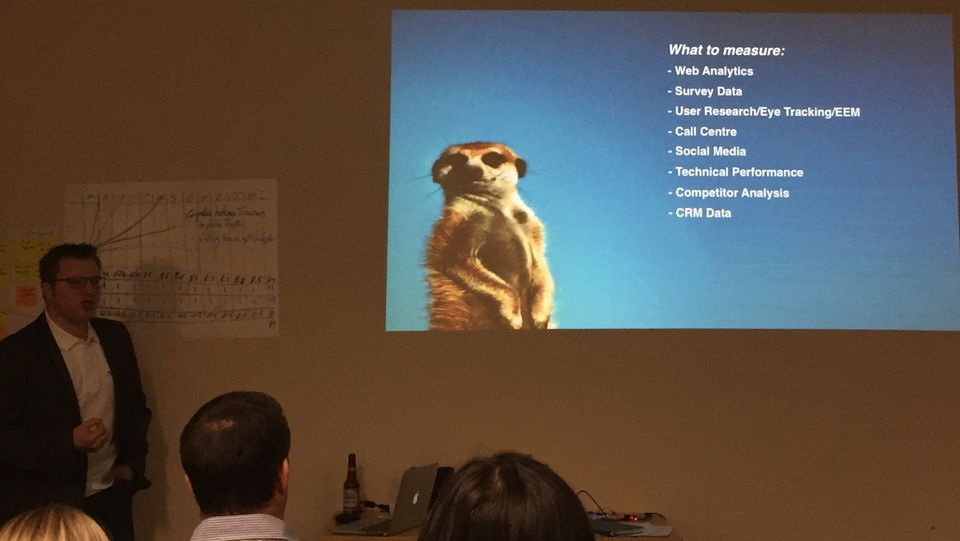Customer Experience and Data: Measuring Experience

Disclaimer: I can’t claim to be impartial when it comes to NUX Newcastle as I’m one of the organisers. Not that my event writeups tend to be particularly hard hitting to start off with….
It’s been far too long since there was a UX meetup group in the North East. There was a UX North East user group a couple of years ago that petered out (and has the twitter account—that no one can find login details for—to prove it) but it’s been a bit tumbleweeds around here apart from annual events such as Digital Union UX Day, DIBI, and Industry Conf.
So, it’s been great to be able to not only have something new pop up for it, but it also be part of a wider community showing that UX does happen outside the M25. Northern UX has been going for nearly 7 years in Manchester, over 4 years in Leeds, and even has three conferences under their belt (with the fourth in October and a workshop day coming soon) … but hadn’t made it to the North East. Until now.
The inaugural event took place at Campus North, with nearly 50 people from a range of UX and tech backgrounds packing out the space.
Packed at #nuxuk for #NCL pic.twitter.com/qVYWZUuHIC
— Vicky Teinaki (@vickytnz) March 18, 2015
Taking up the gauntlet for first speaker of the event was Sean Burton of Analyt: “say it ‘anna-light’, if you misspell it online you can end up in some very bad places”. He admitted the name is partly because of the play on words of being an analyst and therefore being a bit anal. However, the real inspiration is a bit more interesting, and informed by his wife’s work as a chemical biologist – it’s a corruption of analyte, a chemical that cannot be measured. Which is a nice encapsulation of the dilemma of the UXer, namely the tension between what can be measured (tasks) and what can’t (meaning, intent etc).
Usability 'recognises that people can be lazy'; true words from @sean_d_burton. #nuxuk #ncl #analytchat #ux pic.twitter.com/ZgIlLsWe23
— Orange Bus (@orangebus) March 18, 2015
Burton’s background is in big e-commerce such as telcos, and used his experiences to inform the talk. He noted that there are a number of conflicts that UXers working in ecommerce have to deal with – the focus on bringing in new customers rather than looking after existing ones, the problem that 80% of companies think that their service is superior but only 8% of their customers agree (the stat was from 2006 but Burton still felt it applies today), the fact that far too many people and even organisations are cavalier with what they think is ‘anonymised’ data but in fact is not.
That said, he’s not personally a fan of the term ‘user experience’ as “it feels a bit geeky, I prefer talking about people, customer experience.” People are irrational, do unexpected things … and we should expect that.
Design vs User Experience #webdesign #ux #humor #UI #Design #SXSW #SXSW2015 #SXSWInteractive #SXSWi pic.twitter.com/w2fI2HToFN
— Fred Steube (@steube) March 13, 2015
He mentioned some quirks of human behaviour that he knows of based on his background in psychology (which he started in before he moved into tech). For example, peak-end-rule means that people remember the most extreme part (good or bad) of an experience, and the end … which means that while it’s unlikely that you can ever have a uniformly good experience, focusing on a good part and most importantly a good end experience can make all the difference.
@analytdata talking to us about the peak end rule – end on a high! How you can make a lasting impression #nuxuk pic.twitter.com/Jpu8p3IX8o
— Joanne Rigby (@JoanneUX) March 18, 2015
A nice case of peak-end experience in real life: lingerie site Figleaves “apparently” has an option at the end of checkout with gift options called “forgot anniversary?”. This means that the gift will get sent out with a message apologising for the “shipment being late”.
Burton also gave some practical tips for navigating the meaning and measurement chasm, namely by giving pointers on using particular tools.
Web analytics are loved by marketers but can be easily misread: they’re best for trends and watching out for errors, but should be viewed with a pinch of salt in some other situations.
Surveys can be useful but often abused (what person would want to do a 20 page survey when they’re in the checkout?). Burton recommended that you can actually get a lot done with a five question survey:
- Visit intent – what did they want to do?
- Task achievement – were they able to do it?
- Ease of use – how easy was this to do?
- Recommendation (Net Promoter Score)
- Comments – should be kept with a short character limit as someone has to read the data, and a free text field can invite sheets of data. (I’ve been involved in projects where the latter has happened, you’re particularly likely to get a lot when the journey is broken and customers are desperate for help)
More broadly, Burton emphasised the need for businesses to create a strategy including KPIs that were strategic – “it frightens me how few companies know what their website is for, and what ‘good’ looks like for them”, actionable, easy to understand, and based on valid data.
Burton’s slides are now available from Slideshare.
Member discussion